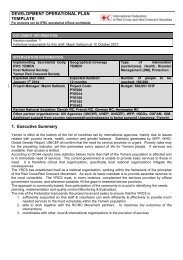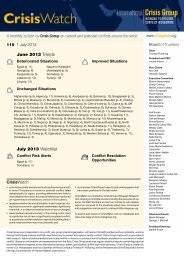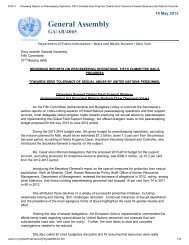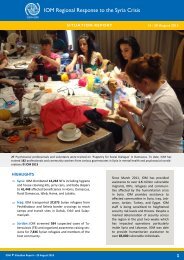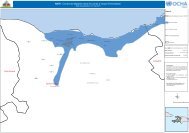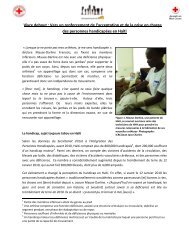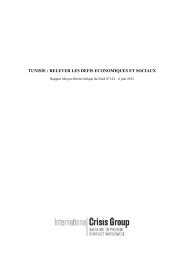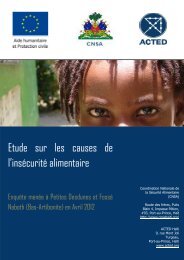SOMALI NUTRITION STRATEGY 2011 – 2013 - ReliefWeb
SOMALI NUTRITION STRATEGY 2011 – 2013 - ReliefWeb
SOMALI NUTRITION STRATEGY 2011 – 2013 - ReliefWeb
Create successful ePaper yourself
Turn your PDF publications into a flip-book with our unique Google optimized e-Paper software.
48<br />
At household level, indicators of food security include number of meals eaten per household<br />
per day and diet diversity or number of different food groups consumed a day. Results from the<br />
micronutrient study 2009 indicate that food security as measured by number of meals eaten per<br />
day is poorer in South Central Somalia where the majority of households (73.7%) consume two<br />
meals a day compared to Somaliland where the majority (64.8%) consume three meal a day. In<br />
Puntland, 45.2% households reported consuming two meals a day while 41.4% consume three<br />
meals a day.<br />
Diversity of the diet at household level also<br />
reflects the adequacy of food access and<br />
availability. Dietary diversity is generally<br />
poor in Somalia and also relates to poor<br />
knowledge and food habits. Diets consist<br />
mainly of cereal (maize or rice) oil, sugar,<br />
seasonably variable access to milk and<br />
occasional access to meat. Vegetables<br />
and/or fruit are rarely consumed.<br />
Patterns differ for pastoralist populations<br />
for whom milk makes more significant<br />
contribution to the diet. According to the<br />
micronutrient study 2009, the percentage<br />
of households consuming less than four<br />
Manoocher Deghati IRIN<br />
foods a day was similar across all three<br />
zones - between 15 and 20% for South Central Somalia and Somaliland and less than 10% for<br />
Puntland; the difference was not significant. The mean number of food groups consumed per day<br />
was 5.52. Results from WFP seven day recall assessment in Somaliland (WFP Food Security and<br />
Vulnerability Assessment 2008), highlight there is large variation by region and livelihood zone.<br />
Overall, 28% of the population consumed less than four food groups in the seven days prior to the<br />
survey but in some areas, up to 45% population consumed less than four food groups. 20% of the<br />
population were only consuming a staple, oil and sugar. 68% had seasonably variable access to<br />
milk and occasionally meat. In Puntland 2007, only 2% of households had a diet that included fruit.<br />
Results from the National Micronutrient and Anthropometric Nutrition survey 2009 also show that<br />
consumption of micronutrient rich foods including fresh fruits, vitamin A rich vegetables fish, eggs<br />
and meat products was generally poor across all three zones.<br />
According to the FSNAU Post Gu 2009 assessment, dietary diversity is particularly poor in Bay<br />
and Bakool regions, where surveys found that 49% of Bay agro pastoralists, 55% of Bakool agro<br />
pastoralists and 61% of Bakool pastoralist households ate less than 4 food groups in the previous<br />
24 hours. According to the same seasonal assessment, Bay and Bakool regions have the highest<br />
rate of chronic malnutrition. The other significant group found to have poor dietary diversity was<br />
IDPs in the northwest; 37% of households consumed less than four food groups a day. Poor dietary<br />
diversity was identified as a main factor contributing to the Very Critical nutrition situation of this<br />
IDP group in the post Gu ‘09 assessment. Generally, urban households are found to have greater<br />
household dietary diversity, according to FSNAU data.<br />
Preliminary results from the FSNAU meta analysis 2001-2008 highlight the link between diet<br />
diversity and nutritional status, finding that children who consumed a less diverse diet (three or<br />
fewer food groups) were 1.12 times more likely (p=0.001) to be malnourished than those who<br />
consumed more diversified food groups.




